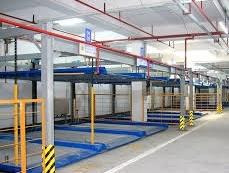As Indian cities continue to grow vertically, the demand for space especially for parking is at an all time high. Roads are shrinking under the weight of traffic, residential and commercial complexes are overcrowded, and traditional parking methods are proving ineffective. This is where the stack parking system comes in as a game changer.
It is not just a modern alternative it is a necessity for managing limited urban space efficiently. This article dives deep into how stack parking systems work, their advantages, types, and their role in reshaping India’s parking infrastructure.
What is a Stack Parking System?
A stack parking system is a mechanical setup that allows multiple cars to be parked vertically, one above the other, using platforms and lifts. It multiplies parking capacity within a given ground area by utilizing vertical space ideal for congested cities where land is expensive and limited.
These systems are designed to safely and efficiently store and retrieve cars using hydraulic or motorized lifts. From small-scale residential buildings to large commercial projects, stack parking is becoming the preferred choice.
Why Stack Parking Systems Are Needed in India
India is home to over 300 million registered vehicles, and this number continues to grow rapidly. However, our cities are not designed to handle such traffic density, especially when it comes to parking infrastructure.
Challenges such as:
- Lack of dedicated parking zones
- Skyrocketing land prices
- Chaotic roadside parking
are pushing municipalities, builders, and developers to look for innovative alternatives. The stack parking system provides an efficient and sustainable solution.
Types of Stack Parking Systems
1. Two-Level Stackers
- Basic system with two platforms.
- One vehicle is raised to allow parking of another below.
- Ideal for homes and small office buildings.
2. Puzzle Parking Systems
- Cars move both vertically and horizontally.
- Allows flexible parking for multiple vehicles.
- Suitable for apartments and mid-sized commercial spaces.
3. Rotary Parking Systems
- Vehicles rotate in a circular motion to reach the desired platform.
- Compact and excellent for narrow spaces.
4. Tower Stack Systems
- High-rise parking towers using automated retrieval systems.
- Common in malls, hospitals, hotels, and smart city projects.
Key Benefits of Stack Parking Systems
Maximized Space Efficiency
Stack systems utilize vertical space, enabling up to 10 times more vehicles to be parked on the same footprint.
Cost-Efficient Land Use
Reduces the need to acquire expensive urban land for traditional parking lots.
Time-Saving
Users can retrieve cars quickly, especially with automated systems no circling around for a spot.
Eco-Friendly
Reduces idle time, saves fuel, and supports lower emissions.
Enhanced Safety
Cars are protected from theft, weather, and accidental damage.
Where Are Stack Parking Systems Used?
- Residential complexes
- Office buildings
- Shopping malls
- Hospitals and hotels
- Public parking near railway stations, metros, and airports
Cities like Mumbai, Delhi, Bangalore, Pune, and Hyderabad are already seeing a surge in stack parking installations, especially in urban hotspots.
Stack Parking System Installation: What to Consider
When installing a stack parking system, consider:
- Available space and height clearance
- Load-bearing capacity of the structure
- Power supply for automated systems
- Fire and safety compliance
Proper planning ensures seamless integration into existing or new constructions.
Maintenance and Safety
Like any mechanical system, stack parking systems require regular inspection and upkeep:
- Monthly hydraulic checks
- Software system diagnostics
- Emergency operation readiness
- Annual maintenance contracts (AMC) are widely offered by service providers
Government Support and Urban Planning
With India’s Smart City initiative, stack parking is gaining acceptance in public and private infrastructure. Building codes and urban development guidelines now allow mechanical parking to fulfill statutory parking requirements.
Development Control Regulations (DCR) in many Indian cities promote or mandate stack parking to enhance land utilization.
Smart Parking Integration
Modern stack parking systems can be integrated with:
- App-based vehicle access
- RFID card usage
- Real-time parking updates
- EV charging options
- Cloud-based monitoring
These features make them future-ready and suitable for smart urban infrastructure.
Discover how the stack parking system is solving urban India’s space crisis. Learn its types, benefits, and why it’s the future of efficient vehicle parking. The stack parking system offers a scalable, space-saving, and technologically advanced solution for India’s growing parking needs. As urban populations expand and real estate becomes scarcer, smart infrastructure such as this will become indispensable. For developers, planners, and property owners looking to maximize land use and provide superior convenience, stack parking is a strategic investment into a more efficient and organized urban future. In a bustling city like Mumbai, where every square foot matters, stack parking solutions are not just innovative they’re essential. By maximizing space, improving convenience, and supporting sustainability, these systems offer a future-ready approach to urban living. If you’re a builder, housing society, urban planner, or business owner, it’s time to think vertical. Stack parking is the solution that Mumbai needs today and for the future. Adopting these systems not only improves functionality but also adds long-term value to your property.












